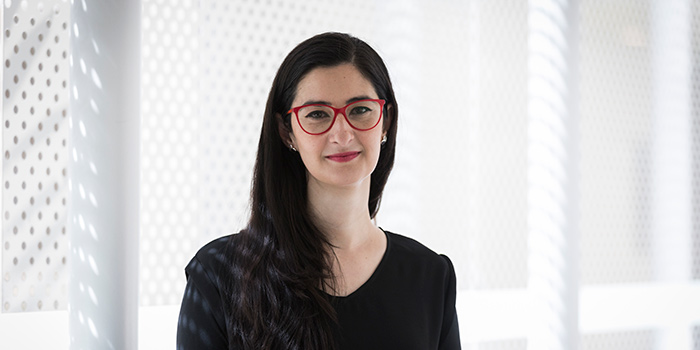Meet Maria Savvidis: librarian at the State Library of New South Wales, NSLA’s Oral History Network lead, and President of Oral History NSW.
Tell us briefly about your career path.
Like many others, my library career started early on as a very earnest library monitor in primary school. After majoring in English Literature and Modern Greek at the University of Sydney I completed my postgraduate studies in Information Management at UNSW.
Over the last 16 years I have worked in specialist libraries in Sydney and London, including academia, arts funding, finance, news broadcasting, and government. In London I was based at UCL’s Science Library in Bloomsbury for almost three years, and sometimes in the Archaeology and Architecture libraries which I loved.
I joined the State Library of New South Wales working on the oral history digitisation project, preparing the metadata for analogue collections to be digitised, and have since worked in the acquisitions and curatorial teams. I’m currently with the Public Library Services branch.
What does your role involve?
The Public Library Services branch provides specialist advice and support to local councils with public library services and staff. This includes libraries using our Amplify platform to create machine generated transcripts for their oral history collections that are then corrected and verified online by real people to make the interviews truly accessible.
My role at the library includes building our oral history collection. I meet regularly with my acquisitions colleagues to discuss and plan around collecting areas, current projects, commissions, and future interviews and projects, liaising with oral historians, community groups and donors.
I also work with colleagues across many different teams at the library, from cataloguing, systems, and digitisation to develop guidelines and recommendations to ensure our oral history collection will be preserved and made discoverable and accessible now and well into the future.
What is your favourite part of working with oral histories?
Hearing people’s life stories, memories and reflections in their own words. Humanity has passed down knowledge, history, and experience through orality since time immemorial, especially right here in Australia which is home to the oldest continuous oral tradition. Oral history is a personal, immediate, and incredibly special way of giving people the opportunity to represent themselves and their own experiences and preserve their story for future generations. It is a powerful format particularly for people and communities who are often overlooked by traditional historical sources or seen to exist in the margins.
What do you think is the greatest challenge facing libraries with oral history collections, now and 10 years from now?
For me it is the trio of digitisation, digital preservation and access. So many recordings made on magnetic media and early digital formats are at risk of being lost forever if they are not digitised in time, but that’s only the first step. Digital preservation is an ongoing challenge now and in the future for many libraries and collecting institutions – especially regarding storage costs and size, changing technologies, infrastructure systems and more.
The library has worked over the last several years to digitise over 12,000 hours of our oral history and sound recordings. Work is currently underway on a new catalogue which will include custom-built viewers for audio and transcripts and will be an important way to share and discover more of our oral history collection with wider audiences. An example of how this will look in the beta catalogue is an interview with Dawn Smith, a Ngiyampaa Elder who discusses the 2017 repatriation of Mungo Man and Mungo Lady within the Willandra Lakes Region World Heritage Area.
Before anything else, oral history really is underpinned by ethics. The balance and careful consideration of how to respectfully treat someone’s personal life story and how, when and if to make interviews accessible (particularly where there are sensitivities, missing documentation, or unclear permissions) is something oral historians and collecting institutions grapple with constantly.
What are you hoping the NSLA Oral History Network might achieve together?
From our first meeting, it was very clear that we are all in the same boat – we have such incredibly rich collections and stories from people across Australia that we want to preserve and make accessible as much as possible, and there are many more still that we want to work on collecting for the future. We are asking many of the same questions, and I am looking forward to learning from each other and finding solutions and approaches to our shared questions and concerns together.
What is your favourite oral history item in the SLNSW collection?
There are so many I’ve listened to over the years from both our legacy collections and recent born digital acquisitions. You can listen to the 14 Mungo Man interviews on Amplify as well as the Islamic faith in NSW collection. I also love the diverse stories from our migrant and refugee communities – we showcased some of them in this 2013 series by Louise Whelan, and there are many more to listen to on our current catalogue.










